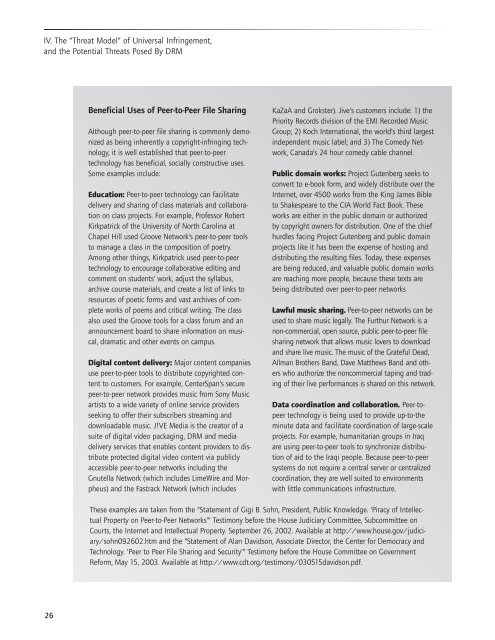What Every Citizen Should Know About DRM, aka - Public Knowledge
What Every Citizen Should Know About DRM, aka - Public Knowledge
What Every Citizen Should Know About DRM, aka - Public Knowledge
You also want an ePaper? Increase the reach of your titles
YUMPU automatically turns print PDFs into web optimized ePapers that Google loves.
IV. The “Threat Model” of Universal Infringement,and the Potential Threats Posed By <strong>DRM</strong>Beneficial Uses of Peer-to-Peer File SharingAlthough peer-to-peer file sharing is commonly demonizedas being inherently a copyright-infringing technology,it is well established that peer-to-peertechnology has beneficial, socially constructive uses.Some examples include:Education: Peer-to-peer technology can facilitatedelivery and sharing of class materials and collaborationon class projects. For example, Professor RobertKirkpatrick of the University of North Carolina atChapel Hill used Groove Network’s peer-to-peer toolsto manage a class in the composition of poetry.Among other things, Kirkpatrick used peer-to-peertechnology to encourage collaborative editing andcomment on students’ work, adjust the syllabus,archive course materials, and create a list of links toresources of poetic forms and vast archives of completeworks of poems and critical writing. The classalso used the Groove tools for a class forum and anannouncement board to share information on musical,dramatic and other events on campus.Digital content delivery: Major content companiesuse peer-to-peer tools to distribute copyrighted contentto customers. For example, CenterSpan’s securepeer-to-peer network provides music from Sony Musicartists to a wide variety of online service providersseeking to offer their subscribers streaming anddownloadable music. J!VE Media is the creator of asuite of digital video packaging, <strong>DRM</strong> and mediadelivery services that enables content providers to distributeprotected digital video content via publiclyaccessible peer-to-peer networks including theGnutella Network (which includes LimeWire and Morpheus)and the Fastrack Network (which includesKaZaA and Grokster). Jive’s customers include: 1) thePriority Records division of the EMI Recorded MusicGroup; 2) Koch International, the world’s third largestindependent music label; and 3) The Comedy Network,Canada’s 24 hour comedy cable channel.<strong>Public</strong> domain works: Project Gutenberg seeks toconvert to e-book form, and widely distribute over theInternet, over 4500 works from the King James Bibleto Shakespeare to the CIA World Fact Book. Theseworks are either in the public domain or authorizedby copyright owners for distribution. One of the chiefhurdles facing Project Gutenberg and public domainprojects like it has been the expense of hosting anddistributing the resulting files. Today, these expensesare being reduced, and valuable public domain worksare reaching more people, because these texts arebeing distributed over peer-to-peer networksLawful music sharing. Peer-to-peer networks can beused to share music legally. The Furthur Network is anon-commercial, open source, public peer-to-peer filesharing network that allows music lovers to downloadand share live music. The music of the Grateful Dead,Allman Brothers Band, Dave Matthews Band and otherswho authorize the noncommercial taping and tradingof their live performances is shared on this network.Data coordination and collaboration. Peer-topeertechnology is being used to provide up-to-theminute data and facilitate coordination of large-scaleprojects. For example, humanitarian groups in Iraqare using peer-to-peer tools to synchronize distributionof aid to the Iraqi people. Because peer-to-peersystems do not require a central server or centralizedcoordination, they are well suited to environmentswith little communications infrastructure.These examples are taken from the “Statement of Gigi B. Sohn, President, <strong>Public</strong> <strong>Know</strong>ledge. ‘Piracy of IntellectualProperty on Peer-to-Peer Networks’” Testimony before the House Judiciary Committee, Subcommittee onCourts, the Internet and Intellectual Property. September 26, 2002. Available at http://www.house.gov/judiciary/sohn092602.htmand the “Statement of Alan Davidson, Associate Director, the Center for Democracy andTechnology. ‘Peer to Peer File Sharing and Security’” Testimony before the House Committee on GovernmentReform, May 15, 2003. Available at http://www.cdt.org/testimony/030515davidson.pdf.26





